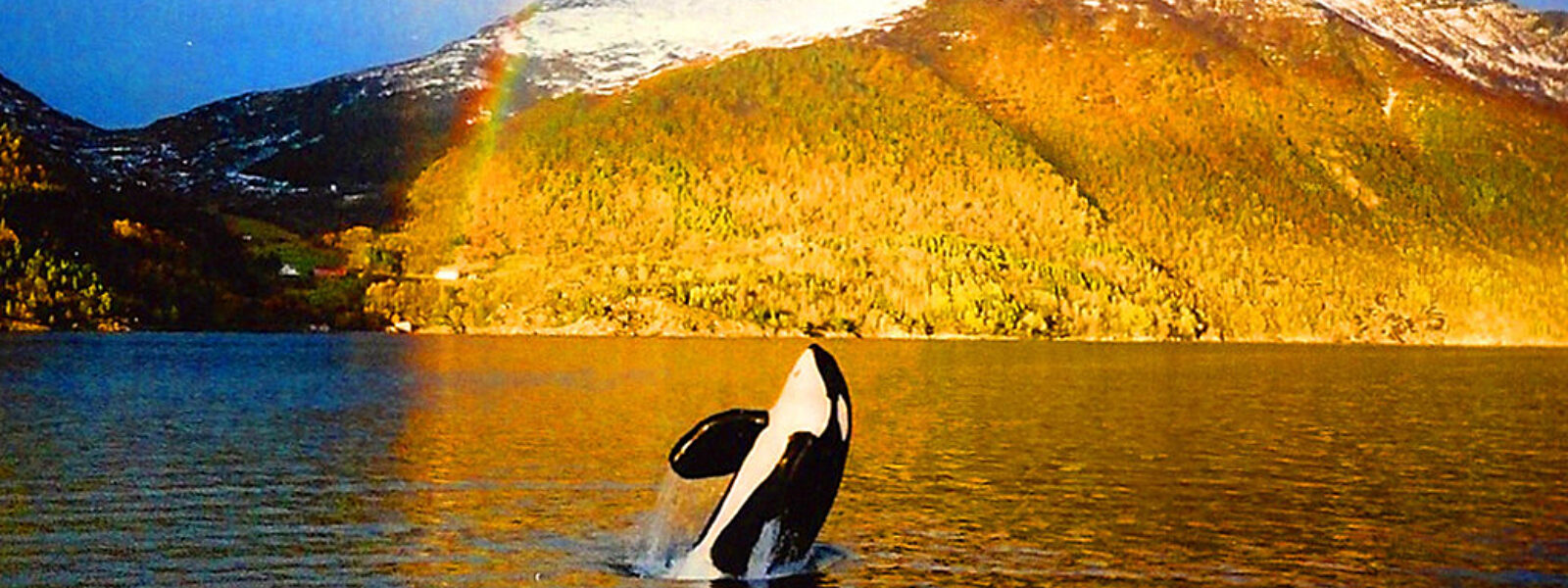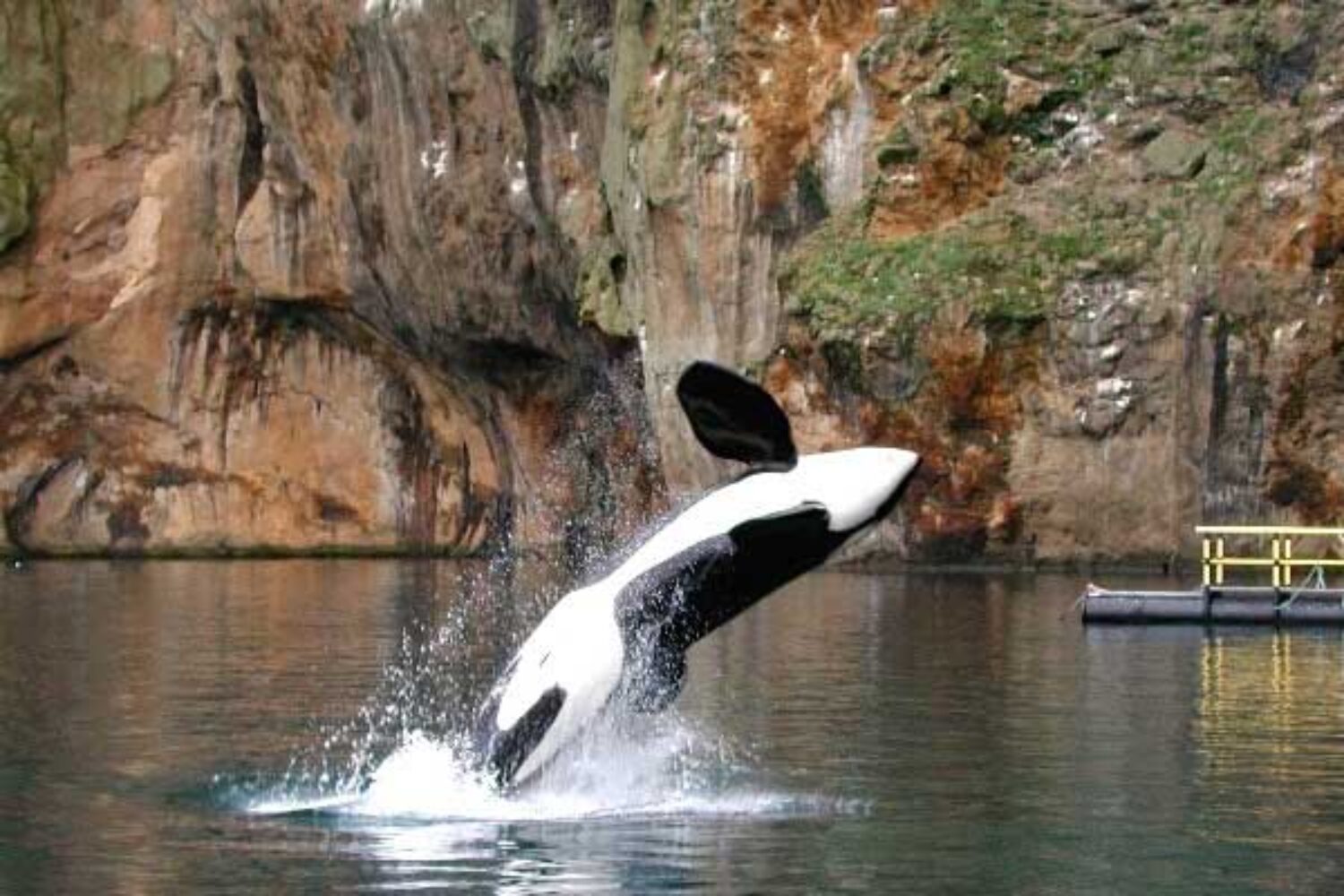
KEIKO, THE ORCA STAR OF FREE WILLY, FAQ
FREQUENTLY ASKED QUESTIONS ABOUT HIS HISTORIC RESCUE
Keiko’s odyssey from a tiny tank in Mexico all the way to swimming in his home waters was a remarkable journey. After rehabilitation in Oregon for several years, Keiko lived for more than 5 years in his bay seaside sanctuary in Iceland, as well as out in the Atlantic waters, sometimes in the company of wild whales, and finally in a protected cove in Norway.
How big was Keiko?
When Keiko was rescued, he was severely underweight at only 7,720 pounds. By the time he was returned to his home waters in Iceland, he had achieved his full length of about 24 feet and weighed approximately 11,500 pounds!
What’s wrong with Keiko’s dorsal fin?
Drooping dorsal fins are rare in wild male orcas, yet happens with almost all male orcas in captivity. There is no known instance of a collapsed dorsal fin ever straightening.
Most scientists believe that this dorsal fin collapse in captive male orcas like Keiko is due to unidirectional swimming in small shallow circles along with a lack of diving due to tanks being too shallow. In the wild, male orcas regularly dive dozens of feet deep, remaining underwater most of the time, and swim fifty or more miles in a day, activities which are thought to strengthen their nearly 6-foot-tall dorsal fins as they grow and develop.
How old was Keiko when he was captured?
Keiko was born in the waters off Iceland in 1977 or 1978 and was about two years old when he was captured by fishermen. Keiko was held in an aquarium in Iceland before being sold to Marineland in Niagara Falls, Canada. Three years later, at age 5, he was sold to Reino Adventura, an amusement park in Mexico City.
Mexico City is a mile high, which means thin air and bright sun. There is also serious air pollution. Keiko’s tank was too warm, extremely small, and filled with tap water mixed with salt rather than real seawater. Keiko was extremely popular with the public, but his health deteriorated during his fourteen years of confinement in Mexico.
How old was Keiko when he was rescued?
The short answer is that Keiko was about 19 years old when he was finally rescued from the tiny tank in Mexico City.
What was his journey to the wild?
While Keiko was trapped in Mexico, in 1992, Warner Bros. began filming the movie Free Willy – the story of a boy who helps free a captured orca from captivity. In addition to digital special effects, the studio filmed Keiko in his Mexico City tank, because US aquariums refused to allow filming the story in their facilities. Keiko was then about 15 years old when Warner Bros. began filming – Free Willy became a surprise hit when released in July 1993.
In 1994, Warner Bros. and Producers Richard Donner and Lauren Schuler-Donner invited the International Marine Mammal Project (IMMP) of Earth Island Institute (EII), our advocacy group for marine wildlife, to put together a plan to rescue and relocate Keiko. Tens of thousands of young people who’d seen the Free Willy film were upset to hear that Keiko was still in captivity, and they wanted action. We began the search for a location where Keiko’s health could be restored, and he could be trained for potential release to the wild.
In November 1994, EII formed the Free Willy/Keiko Foundation (FWKF) with the financial support of Warner Bros. and telecommunication pioneer Craig McCaw and his wife Wendy McCaw. The FWK Foundation built a large, state-of-the-art facility for Keiko at the Oregon Coast Aquarium in Newport, Oregon.
In 1995, Reino Adventura donated Keiko to our Foundation. We announced that Keiko would be moved to the new $7.3 million rehabilitation facility at the Oregon Coast Aquarium. The Humane Society of the United States also became a sponsor. Before Keiko could be moved from Mexico City, we had the water in his tiny tank chilled to be more like his natural habitat.
On January 7, 1996, United Parcel Service stepped forward to donate the airlifting of Keiko from Mexico City to the Oregon Coast Aquarium. Keiko was in very poor health and underweight.
In his large, new aquarium in Oregon, Keiko experienced cool, natural seawater, pumped from the ocean, for the first time in 14 years. It also had a special system to keep it clean without harsh chemicals.
With the help of the Foundation’s veterinary care, Keiko gained more than half a ton in that first year alone, and by year's end his skin lesions had almost entirely healed. He began to learn the kinds of skills he would need in the wild, including how to catch his own live fish.
In 1998, after more than two years of rehabilitation and training, our veterinarian determined that Keiko was in good health. He was catching and eating live steelhead weighing up to 12 pounds each, comprising fully half of his daily intake of food. He had achieved normal weight for his age and was deemed by experts ready to live in a large sea pen in a protected bay in his native waters in Iceland.
After considerable negotiations, the Icelandic government approved our foundation’s proposal that Keiko be allowed to return to a seaside sanctuary in his home waters. We built a large sea pen in a protected bay there. On September 9th, 1998, we arranged for Keiko to be airlifted from his tank in Newport, Oregon and flown by a US Air Force C-17 transport jet directly to Klettsvik Bay in Vestmannaeyjar, Iceland.

Keiko breaching in his seaside sanctuary in Iceland. Photo Credit: Free Willy/Keiko Foundation
Did Keiko ever get to swim free in the ocean?
At first Keiko remained in his sea pen, catching live fish and becoming acclimated to life in the ocean. Soon he was able to swim in the whole netted off bay. Then he began to make forays out into the open ocean, with a guide boat, sometimes even swimming in the company of wild orcas. By the summer of 2002, he was spending considerable time on his own out in the ocean, occasionally with other orcas.
Where did Keiko Go After Iceland?
One day in 2002, he began an epic journey on his own, swimming nearly 1000 miles across the North Atlantic to the coast of Norway. He was totally on his own for close to 60 days without any supplemental food from humans. Based on documented diving behavior and his healthy and robust condition on his arrival in Norway, Keiko’s veterinarian and leading orca scientists concluded that he successfully fed himself over that distance, a major milestone on his journey back to the wild.
Keiko encountered many people and boats in Norway. For his protection from boat propellers and other hazards, he was led to a quieter fjord where he could also go out into the open ocean waters, which he did frequently.
How old was Keiko when he died?
On December 12, 2003, the Free Willy/Keiko Foundation and the Humane Society of the United States reported that Keiko, the orca whale, died in the Taknes Fjord, Norway, in the company of staff members who had been caring for him there. Keiko's veterinarian believes that acute pneumonia was the most likely cause of death.
Keiko was about 26 or 27 years old when he died. Wild male orcas are believed to live from 35 to 50 years or even longer, with females are believed to reach 90 years or more. At the time, Keiko was the second oldest male orca who’d ever lived in long-term captivity. Keiko is the only long-term captive orca who has ever been given the chance to return to his native waters.
Would it have been better to leave Keiko in captivity?
Keiko was in poor health and grossly underweight while in captivity in Mexico. He was able to regain his health in natural seawater. He was also able to relearn the skills necessary to feed himself in the wild and interact with wild orcas in his native waters. None of this would have been possible in a concrete tank.
Evidence shows that keeping orcas in captivity is inhumane and shortens their lives. During the years in which Keiko was rescued, regained his health and returned to his home waters, seventeen other orcas died in captivity, along with many more captive dolphins and whales. SeaWorld, for example, which has sharply criticized the Keiko effort from the beginning, lost eight captive orcas during the time we were caring for Keiko. SeaWorld never talks about all the orcas who have died in their facilities (at least 53 so far). Confining orcas in captivity is a failed experiment. It’s well past time to close this cruel chapter.
We are proud to have given Keiko the opportunity to live out his life in his home waters. What the ocean conservation community learned with Keiko over nearly a decade is helping us all to care for other orcas and dolphins in the most responsible and respectful way. This means establishing seaside sanctuaries – several are open or planned for the near future – to retire captive orcas, belugas and dolphins where they can live out their lives in dignity in the ocean environment.
